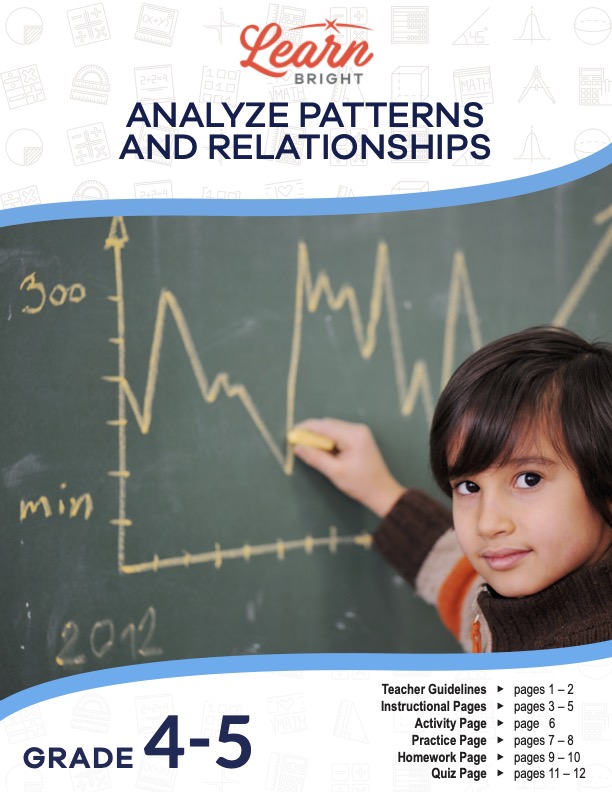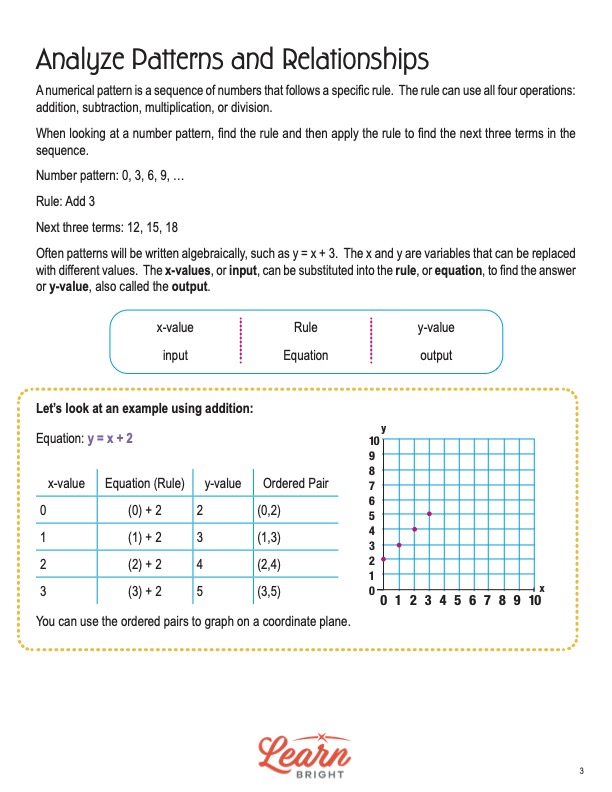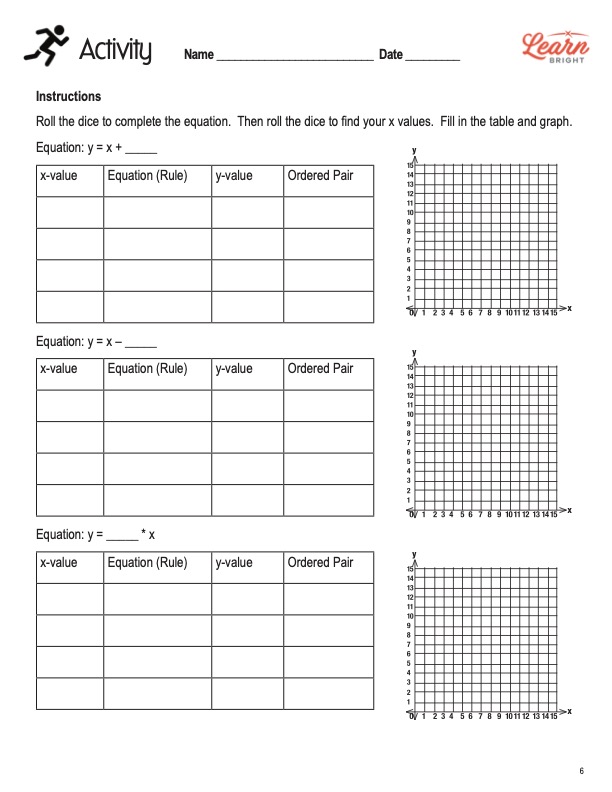Description
What our Analyze Patterns and Relationships lesson plan includes
Lesson Objectives and Overview: Analyze Patterns and Relationships teaches students how to read graphs and tables. Students will learn all about patterns and relationships. At the end of the lesson, students will be able to generate two numerical patterns, find missing terms, form ordered pairs, and graph. This lesson is for students in 4th grade and 5th grade.
Classroom Procedure
Every lesson plan provides you with a classroom procedure page that outlines a step-by-step guide to follow. You do not have to follow the guide exactly. The guide helps you organize the lesson and details when to hand out worksheets. It also lists information in the blue box that you might find useful. You will find the lesson objectives, state standards, and number of class sessions the lesson should take to complete in this area. In addition, it describes the supplies you will need as well as what and how you need to prepare beforehand.
Options for Lesson
Included with this lesson is an “Options for Lesson” section that lists a number of suggestions for activities to add to the lesson or substitutions for the ones already in the lesson. One optional adjustment to the lesson activity is to have your students use different number cubes with various ranges or make your own number cubes out of small wooden blocks with specific numbers based on the skill level of the student. If you have more advanced students, you can begin to discuss functions and function machines where there is an input and output.
Teacher Notes
The teacher notes page includes lines that you can use to add your own notes as you’re preparing for this lesson.
ANALYZE PATTERNS AND RELATIONSHIPS LESSON PLAN CONTENT PAGES
Analyze Patterns and Relationships
The Analyze Patterns and Relationships lesson plan includes three content pages. Numerical patterns are sequences of numbers that follow specific rules. The rule or rules can use all four operations (addition, subtraction, multiplication, or division).
You can look at a number pattern to find the rule and then apply that rule to the next terms in the sequence. For example, for the number sequence 0, 3, 6, 9…, the rule is to add 3. Therefore, the next three terms are 12, 15, 18.
We often write patterns algebraically, like y = x + 3. X and y are variables that we can replace with different values. We can substitute the X-values, also called the input, into the rule or equation. This helps you find the y-value, also called the output.
The lesson then shows students examples using addition, subtraction, multiplication, and division so that students can see an example of each operation. It notes that you can use the ordered pairs that you generate to graph on a coordinate plane.
Some equations use more than one operation. To solve these, you need to substitute the value of x to find the value of y. You can use any number you want for the x values! The lesson includes an example that shows an equation with more than one operation and different x values.
ANALYZE PATTERNS AND RELATIONSHIPS LESSON PLAN WORKSHEETS
The Analyze Patterns and Relationships lesson plan includes four worksheets: an activity worksheet, a practice worksheet, a homework assignment, and a quiz. You can refer to the guide on the classroom procedure page to determine when to hand out each worksheet.
ROLL THE DICE ACTIVITY WORKSHEET
For the activity worksheet, students will roll dice to complete the given equations and to find their x-values. They will use this information to fill in the provided table and graph.
5 TERM SEQUENCE PRACTICE WORKSHEET
The practice worksheet asks students to generate pairs of 5 term sequences with different rules. They will also answer a question about each pair.
ANALYZE PATTERNS AND RELATIONSHIPS HOMEWORK ASSIGNMENT
Like the activity worksheet, for the homework assignment, students will roll dice to complete the given equations and to find their x-values. They will use this information to fill in the provided table and graph.
QUIZ
This lesson also includes a quiz that you can use to test students’ understanding of the lesson material. For the quiz, students will solve and answer three questions.
Worksheet Answer Keys
This lesson plan includes answer keys for the practice worksheet, the homework assignment, and the quiz. If you choose to administer the lesson pages to your students via PDF, you will need to save a new file that omits these pages. Otherwise, you can simply print out the applicable pages and keep these as reference for yourself when grading assignments.









